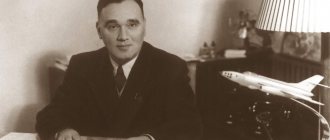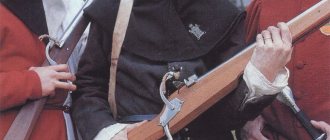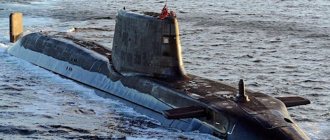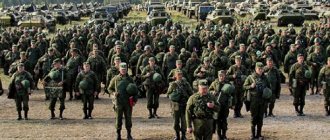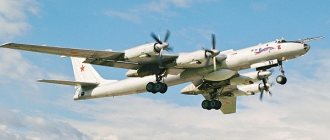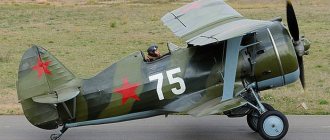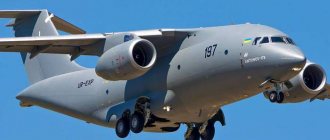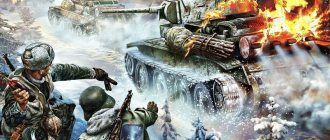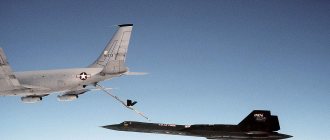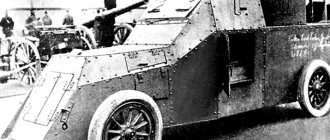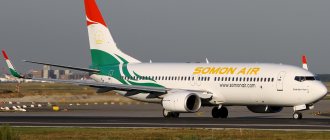Il-78 is a refueling aircraft, developed on the basis of Il-76MD, used to refuel military aircraft in the air. It is the only type of tanker aircraft in service with the Air Force. It is often used as a military transport aircraft (in its modification, the Il-78 lost this ability).
History of IL-78
In the early 70s, due to the need to replace the M-4-2, Tu-16N and 3M-3 tanker aircraft, work began on the development of a new specialized aircraft, built on the basis of the Il-76. But the vehicle became truly suitable for this role only with the advent of the Il-76MD modification (in 1981) with a take-off weight of up to 190 tons. The aircraft was equipped with 2 cylindrical tanks designed for 23,460 liters, which were part of the common fuel system.
On June 26, 1983, the Il-78 made its first flight. It was managed by V.S. Belousov, experienced test pilot. In 1984, the Tashkent Aviation Production Association launched its serial production, which took place simultaneously with the Il-76.
The main difference between the new development and previous tanker aircraft, which were focused on servicing long-range aviation (primarily), was the ability to interact with air defense aviation and front-line aviation. 3 devices were installed on the aircraft (1 in the aft fuselage and two on the wings) UPAZ1, created under the leadership of V.I. Kharchenko and G.I. Severin at the Zvezda Research and Production Enterprise.
The IL-78, in addition to in-flight refueling, can also act as a tanker for transporting fuel. When releasing fuel on the ground, UPAZs are not used; instead, up to four fuel wires go to the intra-fuselage tanks, which are routed through the loading tank. Even for the Il-78, it was possible to convert it into a transport aircraft, for which two fuselage tanks and UPAZs were made removable, and on board there were two cargo winches with a pulling force of 3 thousand kgf, roller conveyor, hoist and mooring and rigging equipment.
IL-78 video
V.S. On March 7, 1988, Belousov made the first flight on a modification of the Il-78M tanker, which had an increased take-off weight of up to 210 tons. The new aircraft did not have the ability to quickly convert into a transport aircraft, since the developers made changes to the design to increase the transported fuel. For example, in the cargo compartment there are 3 non-removable cylindrical tanks designed for 36 tons of fuel, there is no rear loading hatch and landing equipment, which makes it possible to significantly reduce the dead weight of the structure by 5 tons. At the same time, the wing was not strengthened; the fastening of the fuselage refueling unit was changed (the PAZ-1M modification was installed, which turned out to be more productive).
On the Il-78, in-flight refueling is controlled from a separately equipped operator's station, which is located instead of the aft gun mount. In the air, two “light” and one “heavy” aircraft can be refueled simultaneously from underwing UPAZs.
- The IL-78 has a take-off weight of 190 tons, a distance of 100 km from the departure airfield, the ability to transfer 65 tons of fuel and 32-36 tons at a distance of 2.5 thousand km.
- Il-78M: 210 tons - take-off weight, 1800 km - distance from the airfield, fuel transfer - 60-65 tons and 32-35 tons at a distance of 4 thousand km.
These numbers are approximately halved when operating from unpaved runways.
At the end of 1991, 45 aircraft modifications of the Il-78M or Il-78 were produced. Later, in 2003-2006, six more aircraft (Il-78MKI) were created and sent to India.
Fuselage:
semi-monocoque type with round cross-section, has a maximum diameter of 4.8 m.
In the forward part of the fuselage there is a double-deck crew cabin. On the upper deck there are workplaces for the commander, co-pilot, flight engineer and radio operator, and a compartment for persons accompanying cargo or passengers.
The nose of the Il-78M fuselage.
The navigator is located on the lower deck, with space for a second navigator. The crew cabin is separated by a bulkhead from the pressurized cargo compartment. The height of the cargo compartment is 3.4 m, width 3.45 m, length excluding ramp 20 m (with ramp 24.5 m). Cylindrical fuel tanks are installed in the cargo compartment. If necessary, the tanks can be dismantled in a few hours at the airport. The cargo compartment of the Il-78 has a door on the starboard side, while the Il-76 has two doors - on the left and right sides. The cargo compartment ends with a hatch, which is closed by a lowered ramp - a ladder, two side flaps and a middle flap that retracts upward. The space around the cargo hatch is not sealed. There are luggage compartments under the cargo compartment floor. The cargo compartment of the Il-78M aircraft is not sealed, there is no tail cargo hatch, and the removal of fuel tanks from the cargo compartment is not provided.
The cockpit of the Il-78 M aircraft.
The sealed operator's cabin of the aft gun installation is located at the very rear of the fuselage at the base of the fin. The refueling operator's cabin is separated from the unpressurized compartment of the cargo compartment by a bulkhead with a door; on the starboard side in the gunner's refueling operator's cabin there is an emergency hatch-door.
Aerial refueling in the USSR
The Soviet Union also developed various air refueling systems. In 1929, a group of designers led by military engineer A.K. Zapanovannogo created a working system for pumping fuel in the air. In 1936, the world's first in-flight refueling of a fighter aircraft even took place, but the system never reached the stage of practical use. At first, technical problems interfered: the pilot of the refueling vehicle had to manually catch the end of the hose with the attached load and direct it into the filling neck. This was not an easy task, and besides, airplanes with a closed cockpit appeared. And then the work was interrupted by the war.
They returned to this idea after the victory, at a new technical level. In the early 1950s, the original idea of transferring fuel according to the “wing to wing” principle, developed by test pilots I.I., was adopted. Shelest and V.S. Vasyanin. The system was as automated as possible, but was complicated by the docking process, which took place behind the pilots’ backs at the promptings of other crew members, as well as by the location of the hose in the turbulence zone, which often led to an emergency. Nevertheless, the method was successfully mastered and was actively used on Tu-4 and Tu-16 aircraft until they were removed from service.
Refueling MiG-19
In parallel with the wing-to-wing refueling system, a more promising hose-cone system was developed, which later became the main one for refueling fighters and long-range aircraft. During tests in 1953, using this system, two MiG-15 fighters were able to simultaneously receive fuel from a Tu-4 tanker. Two refueling points were located at the wingtips. The released hoses with cones were connected to special telescopic rods mounted on the nose of the fighters.
Since 1953, all new bombers have been designed with in-flight refueling equipment. The first tankers created on the basis of the Tu-4 entered service in 1954, then the Tu-16 came, and at the end of the 1950s, bombers developed at the Myasishchev Design Bureau began to be converted into tankers of the “hose-cone” system.
Chassis:
five-legged, ensures operation of the aircraft from unpaved airfields. All supports are four-wheeled, with transverse wheels.
The nose rotating support is retracted into the fuselage. The main supports are installed in pairs, one after another, in the side fairings-sponsons, and are retracted into niches located under the floor of the cargo compartment. The landing gear niches are completely closed with flaps after the supports are retracted and released.
The chassis and power plant of the Il-78/78M tankers are identical to the chassis and engines of the Il-76MD military transport aircraft.
(ANPRNBNI 78741, GYUB. 0201) YANBEPHK OEPBSHI ONK╦R. ОХКНРХПНБУК YАУЛНК╦Р БЭТ-ОХКНР “хКЭЧХМУ” TSPENNI PNYYAKHIYAYNI TEDEPYUZHHH, GUYAKSFEMMSHY K╦RVKHY-HYAOSHRYUREKE pt mHYNKYUI dLKHRPHEBHV ySHLNB. schryu LYUKHMYU YARUKYU OEPBSHL YYULNK╦RNL-RNOKHBNGUOPYUBYKHYNL, OPNHGBED╦MMSHL B PNYAYAHH B ONYARYANBERYAYKHI OEPKHND. pYUMEE OPNHGBNDYARBN YAYULNK╦RNB xK-78 AYUGHPNBYUKNYAE B sGAEYHYARYUME, YANNAYYUER OPEYA-YAKSFAYU oyun “xK” .
UNR ONKER 25 ЪМБУПЪ 2022 TsNDYU MYUGBYUM oyun “YUBHYUZHNMMSHY YNLOKEYA KHLEMKH ya.b. хКЭЧХХМУ» ОЭПБШЛ ОNKERNL, NDMUYN, ON KhGBEYARMNI KHMTNPLYUZHKH, DYUMMSHI ONKER TYURHVEYAYKH YARYUK RPEREKHL DK DUMMNTSN ANPRYU, YU OEPBSHI ONKER YAYULNKERYU YANYARNKYAJ 19 Ъ MBYUP.
ONYARPNIYU OEPBNTsN NOSHRMNTSN KERMNTsN NAPYUGZHYU YYULNKERYU xK‑78l‑90yu (xGDEKHE 476) NYASYYYARBKERYA B PYULYUU YNMRPYYURYU I lHMHYAREPYARBNL NANPNMSH PNYAHH M YU OPNBEDEMKHE NOSHRMN-YNMYARPSYRNPYAYHU PUANR ON YANGYUMHCH OPYAOEIRKHBMNTsN YYULNKERYU-GYUOPYUBYHYU MU NYAMNBE BNEMMN-RPYUMYONPRMNTSN YYULNKERYU xK‑76ld‑90yu YUY YANYAR YUBMNI VYUYARH NIP “YANGDYUMKHE RF╦KNTSN BNEMMN-RPYUMYAONPRMNTSN YAYULNK╦RYU xK-76ld-90yu X OPYAOEIRKHBMNTSN YAYULNK╦RYU-GYUOPYUBYHYU MU ETSN AYUGE.”
mNBYU SYANBEPEMYARBNBYUMMYU LNDKHTHYUZHKH RNOKKHBNGUOPYUBYUBYHYU YANGDUMYU MY AYUGE MNBEIETSN BNEMMN-RPYUMYAONPRMNTSN YAYULNK╦RYU xK-76ld-90yu. oPNEYRKHPNBYUMKHE X YANGDYUMKHE YNMYARPSYRNPYAYNI DNYSLEMRYUZHH, OPNHGBNDYARBN BNGDSMNTSN YASDMYU NYASYYARBKKNYAE MU NYAMNBE YANBPELEMMSHU ZHTPNBSHU REUMNKNTSKHI.
YaYULNK╦R NYAMYUY╦M VERSHPEL DBHTSYUREKLH MNBNTsN ONYNKEMKH oy-90yu-76 I ONBSHIEMMNI YAREOEMECH DBSUINMRSPMNYARKH SBEKKHVEMMNI BGK╦RMNI RCNI. nMH YANNRBERYARBSCHR MNPLLYUL ON SPNBMCH SLYU MU LEYARMNYARKH, NOPEDEKELSHL RPEANBYUMHLH TsKYUBSH 4 oPHKNFEMKH 16 YARYUMDYUPRYU hyun, Yu RUYFE ON SHCHLHYAYAHH BPEDMSHU B EEYYARB YURLNYATEPS. xU SDEKEMSHI PUYAUND RNOXBYU MU 12−14% MHFE, VELS WITH DBKHTSYUREK d-30yo, SYARYUMNBKEMMNTSN MU OPEDSHDSYKHE LNDKHTHYUZHHH YAYULNK╦RNB-RNOKKHBNGYUOPYUBYKHNB. ONSHRNLS xK-78l-90yu NRKKHVYUERYA ONBSHIEMNI DUKEMNYARECH ONK╦RYU KH LNFER APURE ANKEYEE YNKKHVEYARBN RNOXBYU DK GYUOPYUBYKH YYULNK╦RNB.
ONKMNNYARECH NAMNBNK╦M OHKNRYuFMN-MYUBKHTSYUZHNMMSHY YNLOKEYA, RUYFE MU YAYULNK╦RE PEYUKKHGNBYUMYU "YAREIKЪMMYU YYUAKHMYU", YNRNPYU ONGBNKYER YAMKHGHRE MYUTSPSGYS MU SHCHYKHOYUF KH ONBSHYAHRE AEGNOYUMNYARE ONK╦RNB. MU YAYULNKERE SYARYUMYUBKKHBUERYA ZHTPNBNI OKHKNRYUFMN-MYUBKHTSYUZHNMMSHY YNLOKEYA "jSONK-III-76l", NAYEOEVKHBUCHYKHI PEEMKHE PUGKKHVMSHU GYUDYUV YAYULNKERNBNFDEMKH. b YYUAHME SHYHOYUFYU REOOPE SYARYUMNBKEMN BNYAELE LMNTsNTSMYZHNMYUKEMSHU f-DHYAOKEEB X RPH KHMREKKEYRSYUKEMShu OSKERYU SOPIUBKEMKH.
rNOKKHBNGYUOPYUBYHY xK-78l-90yu YANUPYUMHK BNGLNFMNYARE HYAONKEGNBYUMKH B YUVEYARBE BNEMMN-RPYUMYAONPRMNTSN YAYLNK╦RYU: EYARE PYULOYU, DEYUMRMNE NANPSDNBYUMKHE. oEPENANPSDNBYUMHE ME RPEASER ANKENTSN NAZ╦LYu PYUANR X NYASYYYARBKERYA B SYAKNBKHU YUSCHPNDPNL. b YAKSVUE MENAUNDHLNYARKH MU YAYULNK╦R LNFER ASHRE SYARYUMNBKEMN NANPSDNBYUMKHE DK ONFYUPNRSIEMH.
b OEPYAOEIRKHBE xK-78l-90yu YARYUMER NYAMNBMSHL RNOKHBNYUOPYUBYKHNL, OPKHYAONYANAKEMSHL DK DNGUOPYUBYKH B BNGDSUE YAYULNK╦RNB DUKEMEY, TPNMRNBNI X YaOZHHYUKEMNI YUBHYUZHH . nM YAONYANAY OPNKHGBNDHRE NDMNBPELEMMSC GYUOPYUBYS DBSU YYULNK╦RNB TPNMRNBNI YUBKHYUZHKH (RHOYU YaS-27/30/34/35, lHts-29/35). I am UBNYARNBNTsN YuTsPETSYURYU BNGLNFMYU GYUOPYUBYU YYULNK╦RNB DUKEMEY X YAOEZHHYUKEMNI YUBHYUZHHH. oPH HYAONKEGNBYUMHH xK-78l-90yu MU GELKE BNGLNFMYU NDMNBPELEMMYU GUOPYUBYU DN VERSHP╦U BNGDSMSHU YSDNB.
BYAE PYUANRSH ON LNDEPMHGYUZHHH YYULNK╦RYU NR MYUVYUKYU OPNEIRKHPPNBUMHЪ X DN BSHOSYAYU K╦RMNTSN NAPYUGZHYU OPNBNDHKHKYAE B ZHTPNBNI TNPLE I OPHLEMEMHEL YANBPELEMMSHU YNLOECHREPM SHU YAHYAREL. YNMYARPSYRNPYAYN-REUMNKNTSHVEYAYU DNISLEMRYUZHKH MU KhGDEKHE ONKMNYARECH OEPEBEDEMYU B SHCHKEIRPNMMSHI BHD X GYUOSYEMYU B YAEPKHIMNE OPNKHGBNDYARBN B YANBPELEMMSHU ZHTPNBSHU REU MNKNTSHU.
MU YAYULNKERE ASDER SYARYUMNBKEMN RNOXBN‑GUOPYUBNVMNE NANPSDNBUMHE: DBU DNONKMHREKEMSHU RNOKHBMSHU AYUYU NAYEI ELINYARECH NYNKN 50 RNMM BMSRPKH TsPSGNBNI YUAKHMSH, YU RUYFE S MHTHTHZHHPNBUMMSHE ONDBEYAMSHE YUTSPETSYURSH DNGYUOPYUBYKH - DBYU MU YPSHKE KH NDHM B UBNYARNBNI VYUYARKH TCHGEKKFYU.
MU OPEDOPHYRKHH "gBEGDU", PUYAONKNFEMMNL B ONDLNYAYNBMNL ONYAKYE RNLHKHMN, KHDER PUGPYUANRYU MNBNTsN SMKHTKHHPNBUMMNTSN ONDBEYAMNTsN YuTsPETSYURYU GUOPYUBYH ONBSHYEMM NI OPNHGBNDHREKEMNYARH soyug 1l. nM YUY PYUG X OPEDMYUGMYUVEM DK ONDBEYAYKH MU YAYULNKER-GYUOPYUBYHY xK 78l-90yu. TsKYUBMYU NYNAEMMNYARE SOYUGYU - ECN YUBRNMNLMNYARE. b YUVEYARBE OEPEYUVKHBUCHYETSN MYUNYAYU B YUTSPETSURE SYARYUMNBKEM DBSUYARSOEMVYURSHI ZHEMRPNAEFMSHI MUYANYA I OPHBNDNL NR RSPAKHMSH, HYAONKEGSCHYE SCHMEPTSKHCH MUAYETSYUCHYETSN ONRNYU. YuTsPETSYUR soyug 1l DNAFEM NAEYAOEVHBURE DNGYUOPYUBYS RNOXBNL B ONKERE YYULNKERNB DUKEMEY, TPNMRNBNI X YAOJHYUKEMNI YUBKHYUZHKH, NANPSDNBYUMMSHU YAHYARELYULH OPHELYU RNOXBYU B ONKERE. ON YAPYUBMEMHCH I OPEDSHDSYHLH PYUGPYUANRYUMMSHLH HGDEKHЪLH (soyug, soyug 1) B soyug 1l SBEKHVEMYU OPNHGBNDHREKEMNYARE I 2 300 DN 3000 KHRPNB RNOXBYU B LHMSRS. ShRN SDIUKNYAE YADEKYURE GYU YAVER OPHLEMEMKH MNBNTsN RSPANMYYANYAMNTSN YUTSPETSYURYU rmyu 150l I RSPAKHMNI SBEKKHVEMMNI LNYNYARKH. RUYFE HGDEKHE SOYUG 1L OPEDKYUTSUERYA SINLOKEIRNBURE MUYANYAMNI YARYUMZHHEI I SCHKEIRPNOPKHBNDNL, DYURVKHYNL STSKNBSHU OEPELEYEMHI X YAKHYARELNI YAHTSMYUKHGYUZHHH N ONFUPE yano -62.
b YUTSPETSYURE soyug 1l YAKHYARELYU SOPYUBKEMKH YUBRNLYURKHYNI ONYARPNEMYU MY AYUGE AKNYU YUBRNLYURKHYH X HMTNPLYUZHHH ayuh. oPHLEMEMKHE ZHTPNBNTSN AKNYU SOPYUBKEMKH ayuh, YANGDUYUELNTSN MU AYUGE YANBPELEMMNTSN NREVEYARBEMMNTSN OPNZHEYAYANPU, ONGBNKYER:
- ONKSVKhRE TSHAYKHE BNGLNFMNYARKH OPEYARPNIYKH YUKTSNPKHRLNB PYUANRSH KHDEKKH OSREL OEPEOPNTsPYULLKHPNBYUMKH AKNYU;
- NPTsYUMKHGNBURE ZHTPNBSHE YUMYUKSH NALEMYU DUMMSHHLH I YAYULNKERMSHLH YAHYARELYULH H yoyu I ONLNYECH KCHASHU OPHLEMYELSHU MU YAETSNDMYMKHI DEME B KERYUREKEMSHU YOOYUPYURYU KHMREPT INSB;
- YAMYUADHRE KHDEKHE YUBRNMNLMSHL PETSKHYARPYURNPNL SHYAOXYURYUZHNMMSHU OYUPYULERPNB X OYUPYULERPNB PYUANRSH.
b OEPYAOEIRKHBE I OPHLEMEMHEL AKNYU ayuh B HGDEKKHH soyug 1l ONЪBHRYA BNGLNFMNYARE NAEYAOEVHRE YUBRNLYURKHVEYAYNE PETSKHPNBYUMHE OYUPYULERPNB YAHYARELSH GYUOPYUBYKH.
NYNMVYUREKEMYU YAAPHIMSHU RNOKHBNYUOPYUBYKHINB ASDER NYASYYARBKRREYA MU SKEMNBYAYNL GYUBNDE "YUBHYUYARYUP-yao", TsDE B MUYARNYEE BPEL BEDSRYA PUANRSH ON SYARYU MNBYE ONRNVMNI KHMXX NYNMVYUREKEMNI YAANPYKH RЪF╦KSHU BNEMMN-RPYUMYAONPRMSHU YYULNK╦RNB xK-76ld-90yu X RNOKHBNGYUOPYUBYKHINB xK-78l-90yu. kХМХЪ YANYARNHR ХG MEYAYNKEIKHU YARYUMZHKHI, NAEYAOEVKHBUCHYKHU ONKMSCH YANPIS YYULNK╦RNB. NDMYU HG YAYULSHU BYUFMSHU √ YARYUMZHH YARSHYNBYKH NRYAYNB TCHGEKKFYU H YAANPYH OKYUMEPYU, YNRNPSHE BYKCHVYUCHR B YAAYAREMDSH AEYAYARYUOEKEMNI YUBRNLYURHGHPNBUMMNI YANPHYCH PN YAYAHYAYNTSN OPNKHGBNDYARBU. yUBRNLYURKHYUZHKH OPNZHEYANB SLEMEWER BPEL YARSHYNBYKH TCHGEKKFYU KH YAANPIKH OKUMEPYU. yNMRPNKE GYU OPYUBKHKEMNYARECH YAANPIKH ASDER BSHONKMREYA YAPEDYARBYULH KYUGEPMN-NORHVEYAYKHU HGLEPHREKEMSHU YAHYAREL.
MNBYU KKHMKH ONGBNKHR YAMKHGHRE RPSDN╦LINYARE YARSHYNBNVMSHU PUANR, NAEYAOEVKHRE YNMRPNKHPSELNE YUVEYARBN, SLEME'KHRE GYUBKHYAHLNYARE NR YBYUKHTHYUZHHH REUMKHVE YAYNTSN OEPYANMYUKYU.
cru:
| lNDHTHYUZHH | xK-78l-90yu |
| pYUGLUU YPSHKYU, L | 50.50 |
| dKKHMYU YAYULNKERYU,L | 46.60 |
| bSHYANRYU YAYULNKERYU,L | 14.16 |
| OKNYYUDE YPSHKYU, L2 | 300.00 |
| I love it, JC | |
| OSYARNTSN YAMYUPFEMMNTSN YYULNKERYU | 98000 |
| LYUYAHLYUKEMYU BGKERMYU | 210000 |
| RHO DBKHTSUREK | 4 RPDD Oya-90yu-76 |
| rtsyu, ytsya | 4 U 16000 |
| LYUYAKHLYUKEMYU YAYNPNYARE, YL/V | 850 |
| yPEIYEPYAYU YAYNPNYARE, YL/V | 750-800 |
| YAYNPNYARE OPH DNGYUOPYUBYE, YL/V | 400-600 |
| oPUYRHVEYAYU DUKEMNYARE, YL | 7300 |
| DYUKEMNYARE DEIYARBKH, YL | 5000 |
| oPUYIRKHVEYAYKHI ONRNNKNY, L | 12100 |
| ShYKHOYUF, VEK | 7 |
| ONKEGMYU MYUTSPSGYU: | LYUYAKHLYUKEMYU MYUTSPSGYU - 109500 K RNOXBYU HKKH 52,000 YC TsPSGYU (LYUYAHLLYUKEMN - DN 60,000 YC) |
| bottom. KhMTNPLYUZHKH: |
| tNRNCPYUTHH: | oEPBSHI ONKER xK-78l-90yu (c) YuKEYYUMDP TsSY |
| xK-78l-90yu (c) yuKEYAYUMDP tsSY | |
| xK-78l-90yu (c) yuKEYAYUMDP tsSY | |
| xK-78l-90yu (c) yuKEYAYUMDP tsSY | |
| xK-78l-90yu (c) xBYUM gSANB |
| YaOHYANY HYARNVMKHYNB: |
| oyun "xK". yaYULNKER-RNOKHBNGUOPYUBYHY xK-78l-90yu Aviation21.ru. YaYULNK╦R-RNOKHBNGYUOPYUBYHY xK-78l-90yu YANBEPHK OEPBSHI ONK╦R Bmpd. yaANPYU OEPBNTSN YYULNKERYU-GYUOPYUBYBYHYU xK-78l-90yu MU “YUBHYUYARYUP-yao” Russianplanes.net. xKECHHM xK-78l-90yu |
sTSNKNY MEAYU. 2019
Control system:
rigid, with irreversible hydraulic boosters in all channels, there is an emergency manual control system. A feature of the control system is the combination of hydraulic boosters, tanks with working fluid and control surface drives into single structural units.
Controls - steering columns, pedals and throttles. Aircraft control, with the exception of the throttle control, is completely duplicated by the commander and co-pilot; The engines are controlled by a flight engineer.
The SAU-1T-25 automatic control system provides automatic and directional aircraft navigation along a given route and landing approach up to a height of 60 m.
The cockpit instrumentation is made using analog scale-type instruments.
Specifications
- Length - 46.54 m
- Height - 14.76 m
- Wingspan - 50.5 m
- Wing area - 300 m2
- Crew - 6 people
- Maximum take-off weight - 190 tons (Normal 170 tons)
- Thrust - 4 × 12300 kgf
- Maximum speed - 830 km/h
- Cruising speed - 750 km/h
- Practical range - 7300 km (With full fuel tanks for refueling - 4000 km)
- Practical/Strategic ceiling - 11230 m
Read Mig 1.44 MFI - 15 years ahead of the T-50
Target equipment:
includes the PNPK-76 “Kupol-76” flight-navigation and sighting system, the “Korund” ground surveillance radar, and the “Groza-40” weather radar. The radio equipment includes radio navigation systems, HF and VHF transceiver radio stations, and a state identification system transponder.
View of the refueling operator's cabin from the cockpit of a refueling fighter aircraft.
The aircraft is equipped with an electromagnetic radiation warning system. The aircraft is equipped with a short-range navigation radio system “Vstrecha”, which ensures that refueling aircraft approach the tanker; the range of the RSBN-75 “Vstrecha” system is about 300 km.
"Hose with a loop" and "flying arrow"
In-flight refueling was accepted by the global aviation community, and a new round of pursuit of flight range records began. In 1929, the crew of the Atlantic-Fokker C-2A aircraft spent almost 7 days in the skies, refueling 42 times in the air. And in 1935, a record of 27 days in the air was set: for the sake of victory, pilots were ready to live for weeks in cramped cockpits, repairing and refueling aircraft themselves.
In the 1930s, the refueling system was improved by the Royal Air Force. In addition to increasing the range, another reason appeared - reducing the weight of the aircraft during takeoff. This made it possible for the bombers to carry more weapons on board. The first in-flight refueling system, a “hose with a loop,” appears using special grips and steel cables.
Refueling an Atlantic-Fokker C-2A Question Mark from a Douglas C-1 transport, 1929.
The Second World War, which accelerated the development of technology in military aviation, on the contrary, led to stagnation in the direction of aerial refueling. The leading countries acquired large aircraft whose own fuel reserves were sufficient for long-distance flights. The idea of sky tankers was returned to in the United States during the Cold War, when the distances for delivering lethal weapons to the USSR increased, and again it was necessary to increase the flight range. Existing refueling systems had shortcomings and required improvement.
By the late 1940s, the United States already had two refueling squadrons assembled from modified B-29 bombers. At the same time, Boeing was developing a “flying boom,” which consisted of a telescopic tube with rudders at the end. The boom was lowered by the operator and “flew” to the connector on the receiver of the aircraft being refueled. This design allowed for more precise control of the refueling operation at high speeds and pumped six times more fuel per minute than before. In the mid-1950s, specialized KC-135 air tankers appeared in the United States, which in the event of an attack were supposed to ensure the flight of B-52 bombers to the territory of the USSR.
Payload:
The aircraft is equipped with three universal refueling units UPAZ-1 with a capacity of 2200 l/min (the IL-78M is equipped with UPAZ-1M units with a capacity of 2340 l/min), two units are mounted on pylons under the wing, one is mounted on a cantilever pylon on the left side in the tail fuselage parts.
The main payload of the aircraft is fuel; the fuel supply in the wing caisson tanks is 84,840 kg; the capacity of two tanks installed in the cargo compartment is 2800 kg (for the Il-78M it is 36000 kg).
UPAZ is in working position, the head fairing is shifted forward. Fuel is being pumped into a fighter jet being refueled from an Il-78M.
It is possible to refuel aircraft from the Il-78 at the airfield through four refueling points (two on each side of the fuselage), through these necks the “reverse process” is performed - refueling the Il-78.
Il-78/78M aircraft are often used to transport fuel to remote areas. At a distance from the airfield, a refueling aircraft is capable of delivering 60-65 tons of fuel, at a distance of 2500 km - 32-36 tons. One heavy aircraft (Tu-160, Tu-95MS, A-50, Il) can be refueled from the Il-78/78M -80) or simultaneously two front-line or air defense aircraft (Cy-24M/MP, Su-34, MiG-29SMT, MiG-35, MiG-31D3/BM, Su-30, Su-30SM, Su-35, T -50).
After dismantling the fuselage tanks, the Il-78 can be used as a regular transport aircraft, the mass of the transported payload is 47,000 kg (like the Il-76MD).
With a canister between planes
In-flight refueling allows aircraft to replenish their tanks with fuel without landing, while flying. Today this is an everyday process for military pilots, which, however, requires serious preparation. Try to imagine that you need to refuel your car at high speed from a tanker truck driving nearby. According to pilots, refueling in the air, especially at night, is a technically more complex process than docking spacecraft.
Already at the dawn of aviation, designers were thinking about how to increase the flight range of winged aircraft, and the most obvious idea was to increase the fuel supply. It is believed that the first idea of refueling airplanes in the sky using a hose was expressed by Russian ace and inventor Alexander Prokofiev-Seversky in 1917. With the Bolsheviks coming to power, he emigrated to the USA, where in 1921 he received a patent for his invention.
Alexander Prokofiev-Seversky
In the same year, the first attempt to transfer fuel from one aircraft to another was recorded in the United States. It was done in an original manner: American Wesley May, with a canister of fuel tied behind his back, moved in the air from one airplane to another and poured fuel into the tank. Obviously this was not the most practical way.
In 1923, the US Army conducted refueling tests using the method proposed by Seversky: a 15-meter hose was lowered from one aircraft to another, the pilot of the refueling aircraft caught the hose and attached it to the tank, and under the influence of gravity, the fuel flowed from tank to tank. For safety, the hose was equipped with a valve that blocked the flow of fuel if the hose was disconnected ahead of time. Thanks to this technique, in 1923 the Americans set several world records for flight duration.
